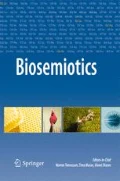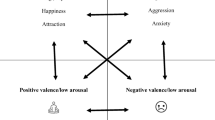Abstract
Environmental signs as physically manifested signs that we and other animals perceive and interpret in the natural environment are seldom focused on in contemporary semiotics. The aim of the present paper is to highlight the diversity of environmental signs and to propose a typology for analysing them. Combining ecosemiotics and the pragmatist semiotics of C. Peirce and C. Morris, the proposed typology draws its criteria from the properties of the object and the representamen of the sign, and of their relationships. The analysis distinguishes eight basic types of environmental signs and provides examples of these from the natural environment. The typology also integrates existing concepts of environmental affordances, ecofields, phonetic syntax, sign fields, ecological codes, meta-signs and others. In addition to basic types of environmental signs, compound environmental signs are discussed with three types of these distinguished: (1) environmental meta-signs; (2) ecological codes; and (3) environmental-cultural hybrid signs. Further study of compound environmental signs could lead to reconceptualising relations between linguistic and pre-linguistic semiosis.
Similar content being viewed by others
Notes
What is the natural environment in semiotic terms is a complex issue on its own. For this paper, I describe this through three characteristics — environment: (1) includes multitudes of Umwelts of organisms of different species and interactions between them; (2) contains physical forces, structures and resources that can be objects of interpretation, that can constrain interpretation or be a context for interpretation; (3) provides conditions for the multisensory and multi-layered semiosis from tactile to symbol-based semiosis.
In some typologies, reagents can be further divided between tracks and symptoms (see Johansen and Larsen 2002: 32).
Relevant to the present topics is also work done in architectural semiotics on “object semiotics”, as a study of structural and functional relations between elements forming an architectural space (Krampen 1979: 6–20).
W. Nöth explains this twofold relation as follows: “The sign vehicle (A) and the referent (B) in this type of natural semiosis are related in two ways. At an extrasemiotic level, the level of natural events, A is the effect of the cause B. At the semiotic level, the effect A becomes an index or symptom which an interpreter connects by inference to B″ (Nöth 1990: 86).
“A sign is vague to a given interpreter to the degree that its signification does not permit the determination of whether something is or is not the denotatum; so the extent that sign is not vague it is precise “(Morris 1971b: 97).
For ecosemiotics, C. Morris’ interpretation of the concept of “meaning” appears to be suitable. This includes not accepting any narrow definition – meaning is not “considered as one thing among other things, a definite something located somewhere”; it is not in the designatum (leading to realism), in the interpretant (leading to conceptualism), or in the sign vehicle (leading to nominalism) (Morris 1971a: 57). Rather, “meanings are not to be located as existences at any place in the process of semiosis but are to be characterised in terms of this process as a whole” (Morris 1971a: 57). From this basis, Morris accepts the subjectivity of meaning (interpretation), which at the same time is compatible with treating every meaning as potentially intersubjective (due to rules and generality of usage) leading to the possibility to study meanings by objective analysis (Morris 1971a: 58–59). For ecosemiotics, a most fascinating perspective is extending this intersubjectivity to the domain of the environmental sphere and to interspecies semiosis.
Interpretation of an unfolding course of a hiking trail by humans could be considered another example of this kind (cf. Lekies and Whitworth 2011).
Consortium “as a group of organisms connected via (sign) relations, or groups of interspecific semiosic links in biocoenosis” is another example of community level signs complex (Kull 2010: 347).
https://en.oxforddictionaries.com/definition/spring (accessed 25.08.2017).
Perhaps the danger to interrupt this natural convention was also the true strength behind the metaphoric title of Rachel Carson’s book Silent spring (Carson 1962).
References
Carson, R. (1962). Silent spring. Boston: Houghton Mifflin.
Chernetsov, N. S. (2016). Orientation and navigation of migrating birds. Biology Bulletin, 43(8), 788–803.
Clark, D. S. (1987). Principles of semiotic. London: Routledge and Kegan.
Eco, U. (1976). A theory of semiotics. Bloomington: Indiana University Press.
Farina, A., & Belgrano, A. (2006). The eco-field hypothesis: Toward a cognitive landscape. Landscape Ecology, 21(1), 5–17.
Farina, A., Lattanzi, E., Malavasi, R., Pieretti, N., & Piccioli, L. (2011). Avian soundscapes and cognitive landscapes: theory, application and ecological perspectives. Landscape Ecology, 26(9), 1257–1267.
Farina, A., Ceraulo, M., Bobryk, C., Pieretti, N., Quinci, E., & Lattanzi, E. (2015). Spatial and temporal variation of bird dawn chorus and successive acoustic morning activity in a Mediterranean landscape. Bioacoustics, 24(3), 269–288.
Farina, A., Pieretti, N., Salutari, P., Tognari, E., & Lombardi, A. (2016). The application of the acoustic complexity indices (ACI) to ecoacoustic event detection and identification (EEDI) modeling. Biosemiotics, 9(2), 227–246.
Favareau, D. (2008). Understanding natural constructivism. Semiotica, 172(1/4), 489–528.
Favareau, D., Kull, K., Ostdiek, G., Maran, T., Westling, L., Cobley, P., Stjernfelt, F., Anderson, M., Tønnessen, M., & Wheeler, W. (2017). How can the study of the humanities inform the study of biosemiotics? Biosemiotics, 10(1), 9–31.
Gibson, J. J. (1986). The ecological approach to visual perception. Hillsdale: Lawrence Erlbaum.
Golledge, R. G. (Ed.). (1999). Wayfinding behavior: Cognitive mapping and other spatial processes. Baltimore: The John Hopkins University Press.
Hewes, G. W. (1994). Evolution of human semiosis and the reading of animal tracks. In W. Nöth (Ed.), Origins of semiosis, sign evolution in nature and culture (pp. 139–149). Berlin: Mouton de Gruyter.
Jaroš, F. (2016). Cats and human societies: A world of interspecific interaction and interpretation. Biosemiotics, 9(2), 287–306.
Johansen, J. D., & Larsen, S. E. (2002). Signs in use. An introduction to semiotics. London: Routledge.
Krampen, M. (1979). Meaning in the urban environment. London: Pion.
Kruis, J. L. (2013). Reading the river: Exploring new applications of ‘text’ and ‘language’. In: Program and Abstracts. Centre of Excellence in Cultural Theory: VI Autumn Conference: Embodiment, Expressions, Exits: Transforming Experience and Cultural Identity. Tartu, October 30–November 1, 2013. (p. 42) Tartu: University of Tartu.
Kruis, J. L. (2017). Shoshone as a text: A structural-semiotic analysis of reading the river as a whitewater raft guide. In A. Kannike, M. Tasa, & E. H. Västrik (Eds.), Body, personhood and privacy: Perspectives on the cultural other and human experience. Approaches to culture theory 7 (pp. 245–265). Tartu: University of Tartu Press.
Kull, K. (1998). Semiotic ecology: Different natures in the semiosphere. Sign Systems Studies, 26, 344–371.
Kull, K. (2010). Ecosystems are made of semiosic bonds: consortia, umwelten, biophony and ecological codes. Biosemiotics, 3(3), 347–357.
Lekies, K. S., & Whitworth, B. (2011). Constructing the nature experience: A semiotic examination of signs on the trail. The American Sociologist, 42(2–3), 249–260.
Liebenberg, L., Louw, A., & Elbroch, M. (2010). Practical tracking: A guide to following footprints and finding animals. Mechanicsburg: Stackpole Books.
Magnus, R. (2016). The semiotic challenges of guide dog teams: The experiences of German, Estonian and Swedish guide dog users. Biosemiotics, 9(2), 267–285.
Malavasi, R., & Farina, A. (2013). Neighbours’ talk: Interspecific choruses among songbirds. Bioacoustics: The International Journal of Animal Sound and Its Recording, 22(1), 33–48.
Maran, T. (2012). Are ecological codes archetypal structures? In T. Maran, K. Lindström, R. Magnus, & M. Toennessen (Eds.), Semiotics in the wild. Essays in honour of Kalevi Kull on the occasion of his 60th birthday (pp. 147–156). Tartu: Tartu University Press.
Maran, T. (2013). Enchantment of the past and semiocide. Remembering Ivar Puura. Sign Systems Studies, 41(1), 146–149.
Maran, T. (2017). Mimicry and meaning: structure and semiotics of biological mimicry. (biosemiotics 16). Spring.
Maran, T., & Kull, K. (2014). Ecosemiotics: main principles and current developments. Geografiska Annaler: Series B, Human Geography, 96(1), 41–50.
Marler, P. (1977). The structure of animal communication sounds. In T. H. Bullock (Ed.), Recognition of complex acoustic signals (report of Dahlem workshop) (pp. 17–35). Berlin: Dahlem Konferenzen.
Mazaris, A. D., Kallimanis, A. S., Chatzigianidis, G., Papadimitriou, K., & Pantis, J. D. (2009). Spatiotemporal analysis of an acoustic environment: Interactions between landscape features and sounds. Landscape Ecology, 24(6), 817–831.
Minai, A. T. (1984). Architecture as environmental communication. Berlin: Mouton.
Morris, C. (1971a). Foundations of the theory of signs. In C. Morris (Ed.), Writings on the general theory of signs (pp. 13–71). The Hague: Mouton.
Morris, C. (1971b). Signs, language, and behavior. In C. Morris (Ed.), Writings on the general theory of signs (pp. 73–397). The Hague: Mouton.
Nöth, W. (1990). Handbook of semiotics. Bloomington: Indiana University Press.
Nöth, W. (2001). Ecosemiotics and the semiotics of nature. Sign Systems Studies, 29(1), 71–81.
Peirce, C. S. (1931–1958). Collected papers of Charles Sanders Peirce, 8. Vol, vols. 1–6, eds. Charles Hartshorne and Paul Weiss, vols. 7–8, ed. Arthur W. Burks. Cambridge, Mass.: Harvard University Press.
Peirce, C. S. (1997). Semiotic and significs: The correspondence between Charles S. Peirce and Victoria Lady Welby. Edited by C. S. Hardwick and J. Cook. Bloomington: Indiana University Press.
Peirce, C. S. (1998). The essential Peirce. Selected philosophical writings. Vol. 2 (1893–1913), ed. Peirce edition project. Bloomington: Indiana University Press.
Polanyi, M. (1962). Personal knowledge: Towards a post-critical philosophy. Chicago: The University of Chicago Press.
Puura, I. (2013). Nature in our memory. Sign Systems Studies, 41(1), 150–153.
Reid, T. (1764). An inquiry into the human mind on the principles of common sense. 3rd ed. London.
Reznikova, Z. (2007). Animal intelligence. From individual to social cognition. Cambridge: Cambridge University Press.
Sebeok, T. A. (2001). Signs: An introduction to semiotics (2nd ed.). Toronto: University of Toronto Press.
Sukhoverkhov, A. V. (2012). Natural signs and the origin of language. Biosemiotics, 5, 153–159.
Vladimirova, E. (2009). Sign activity of mammals as means of ecological adaptation. Sign Systems Studies, 37(3/4), 614–636.
Vladimirova, E., & Mozgovoy, J. (2003). Sign field theory and tracking techniques used in studies of small carnivorous mammals. Evolution and Cognition, 9(1), 1–17.
Wallraff, H. (2005). Beyond familiar landmarks and integrated routes: Goal-oriented navigation by birds. Connection Science, 17(1–2), 91–106.
West, D. E. (2013). Deictic imaginings: semiosis at work and at play. (Studies in applied philosophy, epistemology and rational ethics 11). Berlin: Springer.
Acknowledgements
The research for this article was supported by the institutional research grant IUT02-44 and by the individual research grant PUT1363 “Semiotics of multispecies environments: agencies, meaning making and communication conflicts” from the Estonian Research Council. I express my gratitude to the anonymous reviewers of Biosemiotics for their constructive feedback.
Author information
Authors and Affiliations
Corresponding author
Rights and permissions
About this article
Cite this article
Maran, T. On the Diversity of Environmental Signs: a Typological Approach. Biosemiotics 10, 355–368 (2017). https://doi.org/10.1007/s12304-017-9308-5
Received:
Accepted:
Published:
Issue Date:
DOI: https://doi.org/10.1007/s12304-017-9308-5




